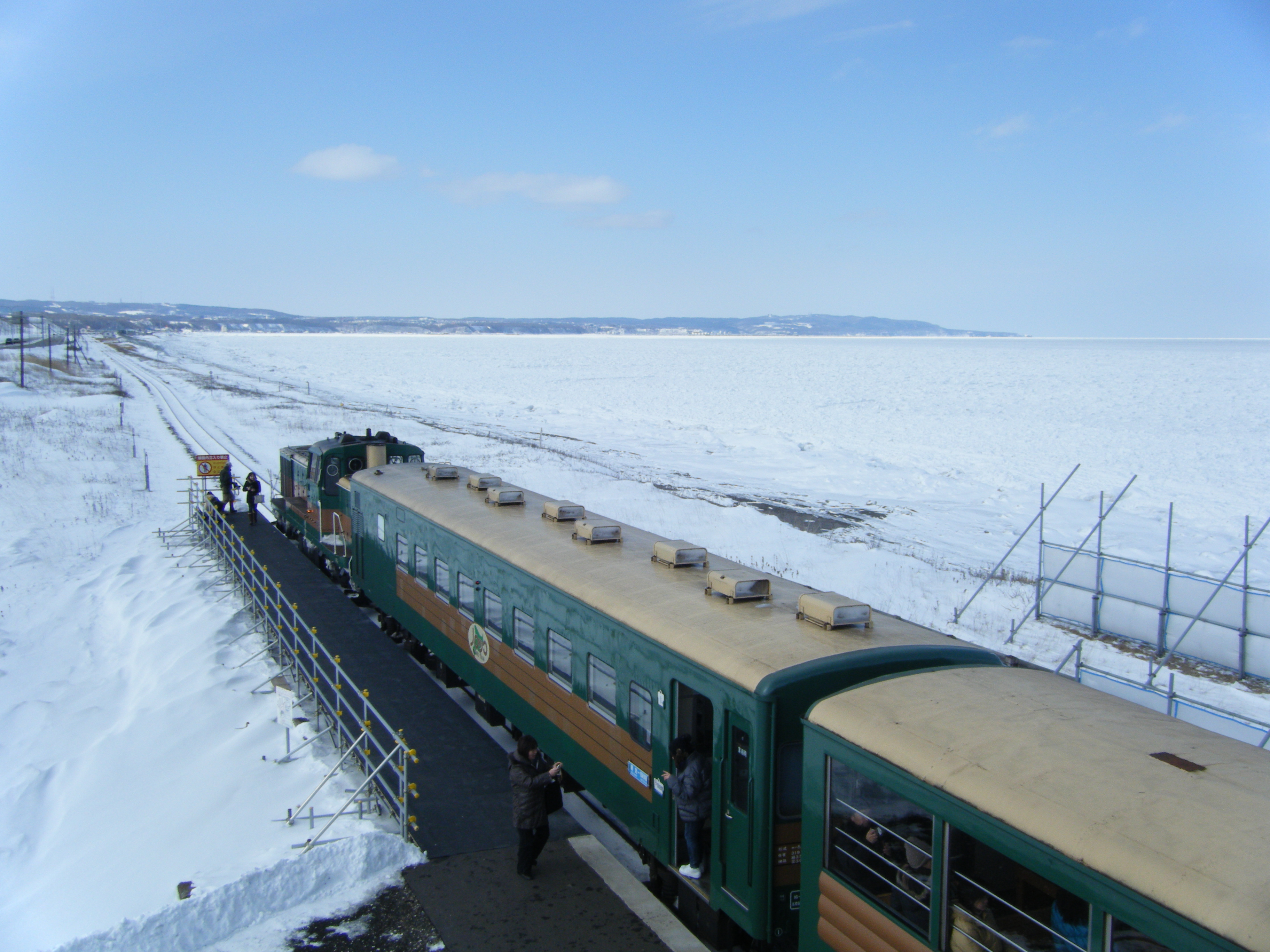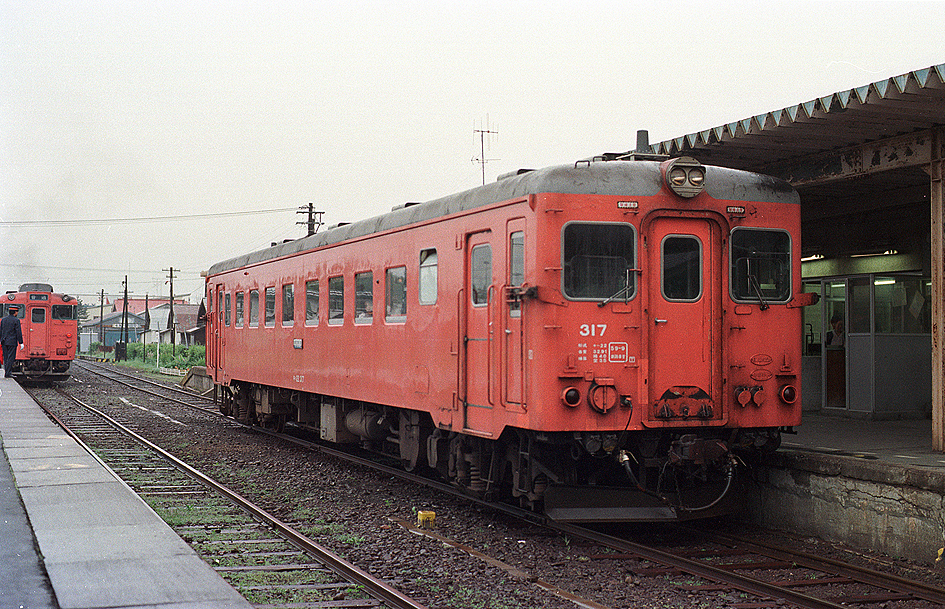Senmō Main Line on:
[Wikipedia]
[Google]
[Amazon]
 The is a Japanese railway line in
The is a Japanese railway line in


 * Abashiri Station - The Yumo Line to Nakayubetsu opened in sections between 1935 & 1952 and closed in 1987.
* Mokoto Station - A gauge line operated to Yamazono (25 km) from 1935 to 1965. A 7 km branch line to Toyo Sawa operated from 1949 to 1962.
* Hamakoshimizu Station - Another gauge line extended 18 km east to service the sugar beet industry between 1941 and 1953.
* Yamubetsu Station - A private railway operated to Koshimizu (9 km) from 1930 to 1939.
* Shari Station - In 1938, fears of Russian naval activity resulted in the decision to build a line to Shibubetsu through the Konpokutoge Pass for defence purposes. Construction was suspended in 1941 following the
* Abashiri Station - The Yumo Line to Nakayubetsu opened in sections between 1935 & 1952 and closed in 1987.
* Mokoto Station - A gauge line operated to Yamazono (25 km) from 1935 to 1965. A 7 km branch line to Toyo Sawa operated from 1949 to 1962.
* Hamakoshimizu Station - Another gauge line extended 18 km east to service the sugar beet industry between 1941 and 1953.
* Yamubetsu Station - A private railway operated to Koshimizu (9 km) from 1930 to 1939.
* Shari Station - In 1938, fears of Russian naval activity resulted in the decision to build a line to Shibubetsu through the Konpokutoge Pass for defence purposes. Construction was suspended in 1941 following the
JR Hokkaido official website
JR Hokkaido official website
{{DEFAULTSORT:Senmo Main Line Rail transport in Hokkaido Lines of Hokkaido Railway Company 1067 mm gauge railways in Japan Dual-mode vehicle
 The is a Japanese railway line in
The is a Japanese railway line in Hokkaido
is Japan's second largest island and comprises the largest and northernmost prefecture, making up its own region. The Tsugaru Strait separates Hokkaidō from Honshu; the two islands are connected by the undersea railway Seikan Tunnel.
The la ...
, operated by Hokkaido Railway Company
The is one of the constituent companies of the Japan Railways Group (JR Group), and is often referred to using its official abbreviation of . It operates intercity and local rail services in Hokkaido, Japan. The company introduced Kitaca, a sm ...
(JR Hokkaido), between Higashi-Kushiro Station
is a JR Hokkaido railway station in Kushiro, Hokkaidō. It is the junction of Nemuro Main Line
is a railway line in Hokkaido operated by Hokkaido Railway Company (JR Hokkaido), connecting Takikawa Station in Takikawa and Nemuro Statio ...
in Kushiro
is a city in Kushiro Subprefecture on the island of Hokkaido, Japan. It serves as the subprefecture's capital and it is the most populated city in the eastern part of the island.
Geography
Mountains
* Mount Oakan
* Mount Meakan
* Mount Akan ...
and Abashiri Station
is a railway station in Abashiri, Hokkaido, Japan, operated by the Hokkaido Railway Company (JR Hokkaido), located. It is the main railway station in the city. Abashiri Station comes first in an alphabetical list of Japanese railway stations (Zus ...
in Abashiri
is a city located in Okhotsk Subprefecture, Hokkaido, Japan.
Abashiri is known as the site of the Abashiri Prison, a Meiji-era facility used for the incarceration of political prisoners. The old prison has been turned into a museum, but the city ...
. The name comes from and . In 2008, a dual-mode vehicle
A dual-mode vehicle (DMV) is a vehicle that can operate on conventional road surfaces as well as a railway track or a dedicated track known as a " guideway". The development of these vehicles started together with personal rapid transport syst ...
was tested on parts of the line.
On 19 November 2016, JR Hokkaido's President announced plans to rationalise its network by up to 1,237 km, or ~50% of the current network, including the proposed conversion of the Senmo Main Line to Third Sector operation, but if local governments are not agreeable, the line will face closure.
Stations

Closed stations
*: since 4 March 2017 *: since 14 March 2020 *: since 13 March 2021Service
Nearly all services on the line are Local services, which stop at every station. The Rapid ''Shiretoko'' train runs between and , with one daily return working.History
In 1887 a private 41 km 1067mm gauge line was opened from a sulphur mine at Atsanobori to a refinery at Shibecha, 48 km north of Kushiro. Known as the Kushiro Railway, it closed 9 years later when the sulphur was mined out. 35 years after it closed the 17 km section of the Senmo line between Mashu - Shibecha was built on the formation of the Kushiro Railway. Construction of the Senmo line started from both Asashiri and Kushiro, with the northern portion opening to Satsutsuru in sections between 1924 and 1929, and the southern portion opening in sections to Kawayu between 1927 and 1930. The Satsutsuru - Kawayu section opened in 1931, completing the line. Freight services on the line ceased in 2002.Former connecting lines

 * Abashiri Station - The Yumo Line to Nakayubetsu opened in sections between 1935 & 1952 and closed in 1987.
* Mokoto Station - A gauge line operated to Yamazono (25 km) from 1935 to 1965. A 7 km branch line to Toyo Sawa operated from 1949 to 1962.
* Hamakoshimizu Station - Another gauge line extended 18 km east to service the sugar beet industry between 1941 and 1953.
* Yamubetsu Station - A private railway operated to Koshimizu (9 km) from 1930 to 1939.
* Shari Station - In 1938, fears of Russian naval activity resulted in the decision to build a line to Shibubetsu through the Konpokutoge Pass for defence purposes. Construction was suspended in 1941 following the
* Abashiri Station - The Yumo Line to Nakayubetsu opened in sections between 1935 & 1952 and closed in 1987.
* Mokoto Station - A gauge line operated to Yamazono (25 km) from 1935 to 1965. A 7 km branch line to Toyo Sawa operated from 1949 to 1962.
* Hamakoshimizu Station - Another gauge line extended 18 km east to service the sugar beet industry between 1941 and 1953.
* Yamubetsu Station - A private railway operated to Koshimizu (9 km) from 1930 to 1939.
* Shari Station - In 1938, fears of Russian naval activity resulted in the decision to build a line to Shibubetsu through the Konpokutoge Pass for defence purposes. Construction was suspended in 1941 following the Soviet–Japanese Neutrality Pact
The , also known as the , was a non-aggression pact between the Soviet Union and the Empire of Japan signed on April 13, 1941, two years after the conclusion of the Soviet-Japanese Border War. The agreement meant that for most of World War II, ...
. Construction recommenced in 1957 to service forestry activity, but was suspended again when the highway was upgraded. The line was opened 12.8 km to Koshikawa, servicing the local community until closure in 1970. A substantial brick arch bridge was built south of Koshikawa before construction was abandoned.
* Shibecha Station;
- A 39 km gauge line opened to Nakashibetsu in 1932. In 1936 it was replaced by a line, which was extended 40 km to Shibetsu, operating until 1989. A branch from Nakashibetsu connected to the Nemuro Main Line
is a railway line in Hokkaido operated by Hokkaido Railway Company (JR Hokkaido), connecting Takikawa Station in Takikawa and Nemuro Station in Nemuro, including Obihiro and Kushiro. Higashi-Nemuro is the most easterly situated station on the J ...
at Attoko between 1933 and 1989, the two branches being known collectively as the Shibetsu Line. A total of 9 separate gauge development lines connected to stations along the Shibetsu Line were built between 1930 and 1963, the last closing in 1971.
- Another gauge system connected the Numahoro District to Shibecha, consisting of a 23 km 'main line' opened 1955, and a 6 km branch opened 1966. Both closed in 1971.
See also
*List of railway lines in Japan
List of railway lines in Japan lists existing railway lines in Japan alphabetically.
The vast majority of Japanese railways are classified under two Japanese laws, one for and another for . The difference between the two is a legal, and not alwa ...
References
External links
JR Hokkaido official website
JR Hokkaido official website
{{DEFAULTSORT:Senmo Main Line Rail transport in Hokkaido Lines of Hokkaido Railway Company 1067 mm gauge railways in Japan Dual-mode vehicle